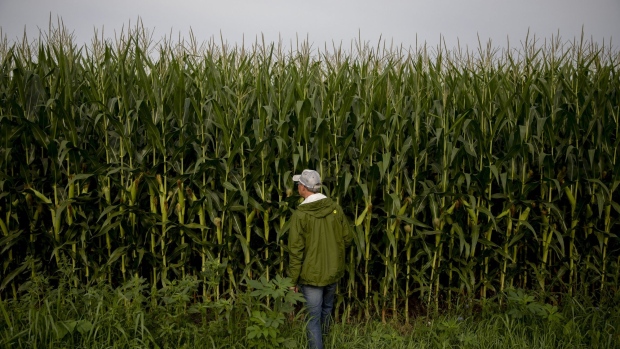Mar 31, 2021
One Fix to Food Inflation: U.S. Farmers Are Planting More Than Ever
, Bloomberg News

(Bloomberg) -- Corn is in the midst of its best rally in a decade, and soybeans have also surged. But the gains weren’t enough to prompt the U.S. government to bulk up its planting estimates, as instead its survey showed that farmers would exercise restraint after years of disappointment.
Acreage for the two biggest U.S. crops will be up from last year, but the increase is falling well short of what traders were expecting. The U.S. Department of Agriculture on Wednesday said that plantings for each commodity will trail the average analyst estimate by about 2 million acres and fail to reach the record that many were forecasting.
The surprise from the USDA sent markets soaring. Soybeans jumped more than 5%, the biggest advance since 2016. Corn traded within about 1% of a mutliyear high reached in February. Concern is growing that if plantings stay at the current USDA-forecast levels, there won’t be enough fresh supply from fall harvests to replenish dwindling stockpiles. That would exacerbate the food inflation that’s already gripping the world.
Commodity markets have taken off in the last six months as reopening economies buoyed demand prospects. Typically, higher prices encourage more output. But in many cases, that surge in supply hasn’t come as producers stay disciplined in a bid to keep markets buzzing and amid skepticism over how much consumption will grow. That’s been true in oil, with OPEC’s top official warning that demand remains fragile just before a meeting to discuss whether the cartel and its partners will prolong vast production curbs.
The fresh USDA figures signal that discipline might also be the watchword in agriculture. Farmers could be staying cautious after suffering through years of sluggish markets, tepid demand and extreme weather. If prices stay near current levels, it will likely mean that crop revenues will finally be high enough for most growers to see a profit this year.
“It’s exciting this year to think about planting a crop where there’s the potential to make real money, because we haven’t done that for several years,” said Ty Thompson, a second-generation corn and soy producer in Galesburg, Illinois, who’s been farming since 1986.
The USDA said farmers plan to seed 87.6 million acres of soybeans this spring, short of the 90.1 million average estimate of analysts surveyed by Bloomberg. Corn is predicted to see seedings of 91.1 million acres, below projections of 93.1 million. The outlook for both crops also trailed USDA estimates from its outlook forum in February.
“Corn and soybean plantings came in lower than expected, with the threat of shortage as a result,” said Bob Yawger, head of the futures division at Mizuho Securities.
Still, skepticsm over the USDA figures was high. The agency does often adjust its plantings estimates over the course of the growing season. The USDA figures are based on close to 80,000 farmer surveys as of March 1.
It’s “hard to believe that total acres are this low,” said Dan Huber, an independent broker. “Not sure I believe” the corn estimate, “but we have to trade it,” he said.
Many farmers were talking about expanding their acreage plans this year before the USDA report. In addition to more corn, soybeans were also seen as a big winner.
Dennis Haugen, who runs a 4,500-acre farm in eastern North Dakota, is planning to expand his soybean acreage by about 10% this year, the most since 2014. In central Illinois, Sean Powell is changing his planting mix for the first time in years, going from a split of 60% corn and 40% soy to 55% and 45%.
And in southeast Iowa, Dave Walton is getting ready to sow the most soy in his more than two decades as a full-time farmer, in part due to field damage caused by last August’s powerful derecho wind storm that flattened corn throughout the state.
But even when farmers want to plant more, there are limiting factors.
Land prices are surging, making it expensive to expand. Fertilizer is also on the rise. Ammonia in Tampa Bay, Florida, is getting bids at $545 per metric ton, more than double trades of $250 a ton from a year ago, according to data from Bloomberg’s Green Markets.
“We are seeing a huge increase in the price of everything we buy to produce a crop,” said Vance Ehmke, who owns a seed company and a 136-year-old farm in Kansas.
The USDA planting forecasts will help growers decide what to do with the acres they haven’t yet earmarked for a particular crop, April Hemmes, a fourth-generation farmer in Iowa, said prior to the report. Growers can also use market moves as hedging opportunities.
“We can really lock in a profit,” said Hemmes, who serves as a director for the Iowa Soybean Association. “People can make an annual salary in one day with this report.”
©2021 Bloomberg L.P.


